Bored, sick
Create an enriching space for veterinary patients that puts healing top of mind.
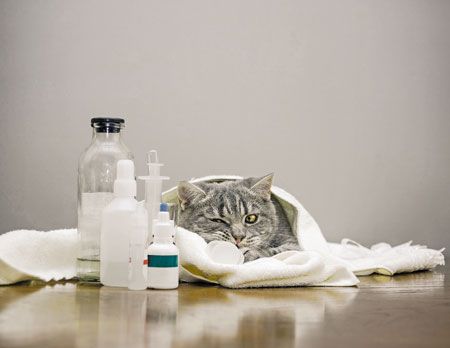
shutterstock.com
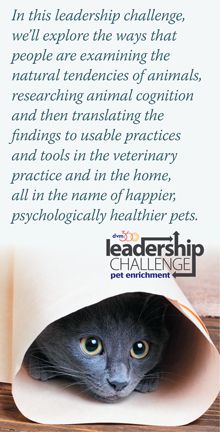
Click here to find more tips and advice on pet enrichment. Your practice was probably designed with hygiene, client comfort and team efficiency in mind. But what about the patient's experience? Whether animals are visiting for a couple of hours or hospitalized for days, you can adapt your environment to create a peaceful, healing space that offers enrichment.
Environmental enrichment is often thought of as a tool to create stimulating environments for zoo animals. But environmental enrichment reaches beyond stimulation to benefit the patient's health. A properly enriched environment supports biological and physiological balance to maximize the pet's well-being. Enriched environments promote the expression of species-typical behavior while providing the option for choice.
Why is enrichment so important?
Consider these reasons:
1. The patient's experience has an immediate and potentially lasting effect on the animal's physical and emotional health. When the environment is in conflict with the patient's needs, patients may experience stress.
Stress has been well-documented to negatively impact health, and it confounds patient monitoring through tachycardia, hyperthermia, elevated glucose, leukocytosis and so on. Patients may also experience delayed healing and lowered immunity due to increased glucocorticoids. And an animal's behavior changes under stress, which can create additional road blocks to your best efforts to offer high-quality care.
2. When patients are stressed, scared or anxious, the effects can spread. For example, when pets react with aggression, team members who provide care may be injured. Team members may also feel frustrated or impatient or even experience compassion fatigue. Emotionally affected team members may demonstrate altered behavior, and their relationships with other team members and veterinarians may suffer. This negativity can flow into the client's visit experience and to additional patients, creating a balloon effect throughout the hospital.
3. Practicing enrichment techniques encourage you to see animals as individuals that need your care. Some patients are better able to manage environments that lack enrichment. This can lead us to believe distressed patients are individually flawed, and we may not recognize the pet's experience. Genetics, overall physical and emotional health status and life experience help determine a patient's coping ability.
Every patient has an individual threshold, and exceeding that threshold causes distress. Each pet enters your practice with a starting level of stress, and each sensory experience (sight, sound, smell, taste and touch) either raises the stress level toward that threshold, maintains or decreases the stress level. Impressionable puppies and kittens and older patients with chronic health conditions may be the most vulnerable.
Every visit is an opportunity to shape the patient's learning history toward a positive, low-stress veterinary experience-and help patients achieve the lowest possible stress level from the time they arrive to when they leave your practice.
First, consider the sensory capability of the species you're working with. Your perception can be a helpful guide, but you'll also need to extrapolate. Dogs and cats have an enhanced sense of smell, and they can hear higher frequencies that shape their experience.
As a start, walk through the facility as if you were a patient. What do you hear? Strange voices, vocalizing animals? What if you were in a metal cage in the hospital ward? Does it echo? Is the metal floor cold? What do you see? What if you were a cat in a carrier with your limited view swaying? Can you smell the cleaning chemicals and anal gland excretion? What if you were a golden retriever? Is the floor slippery under your furry feet? This experiment can help identify areas that may be irritating or fear inducing for patients. Then you can make modifications to alter or mask the offensive stimuli.
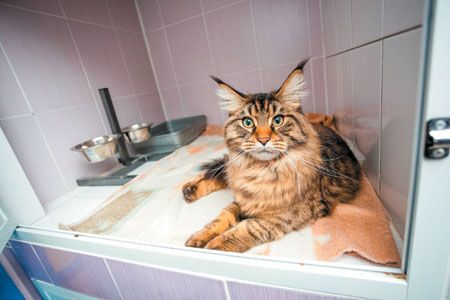
shutterstock.comSound
Barking, yowling, people's voices and veterinary equipment (think ultrasonic cleaner, dental scaler, centrifuge and so on) contribute to indoor sound pollution. Animals begin to show signs of stress when environmental sounds reach 85dB. Sharp, startling sounds can be most damaging. Take these steps to manage sound in your practice.
Monitor and assess your patient areas using decibel meters, which are available as smartphone apps.
Add sound dampening ceiling panels to the hospital ward or kennel to decrease the amplification of barking.
Use white noise machines to supply a consistent background in exam rooms as masking enrichment.
Play calming music designed for pets, which can provide enhancing enrichment.
Avoid fast-paced loud music in patient areas. Team members who prefer this music can use in-ear headphones when appropriate.
Silence alarms on patient monitors and infusion pumps when not attended (for example, overnight) to prevent incessant beeping.
Consider using brooms instead of vacuums when patients are near. Many pets are afraid of vacuums.
Sight
Cats and dogs may be fearful and socially conflicted at the sight of unfamiliar animals. Use creative enrichment with visual barriers to lower fear and stress. Consider these examples:
Cardboard boxes or the bottom of a carrier can allow a hiding place during an exam or inside a cage.
Towels can cover carriers and cage fronts.
Partitions for the lobby or treatment room can include half walls, plants, shelving units, cardboard display boards and free standing pet gates covered with a towel.
Note: You can also modify lighting to enrich wellness. Dogs and cats are more sensitive to light stimuli than people. Consider low wattage bulbs or dimmers in exam rooms, and use spot lighting as needed.
Touch
When an animal is fearful, this often activates the pet's escape response. Slippery surfaces hamper traction and panic can ensue. This can shift the patient into defensive aggression as an alternate coping mechanism.
Provide nonslip abatements for hospital floors, treatment tables, the scale and hospital cages to minimize stress.
You can find many commercially available easily disinfected mat options to enrich smooth surfaces.
Cold veterinary surfaces can also be aversive to patients. Think about how they seek furniture, blankets and beds at home. A towel or blanket provides cushion and warmth. Heated pet beds and pads can be especially enriching for cats and elderly patients.
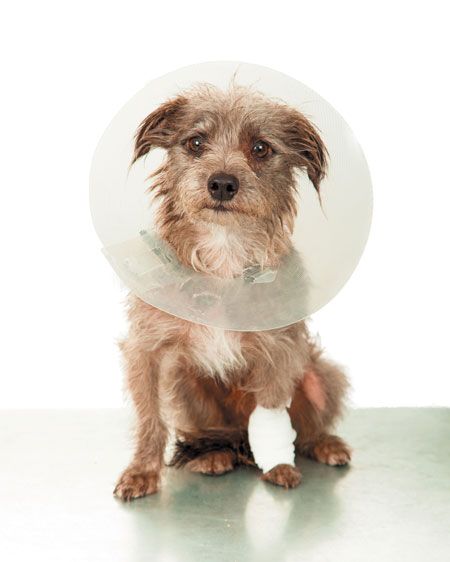
shutterstock.comSmell
Dogs, cats and other species have a vomeronasal organ that processes pheromones that people can't perceive. Pheromones affect emotional states and physiology. Consider these tips to fight the scary smells:
Make sure to clean to remove pheromones that may be linked to fear or alarm from commonly used instruments such as stethoscopes. Similarly, use clean towels for each patient.
Consider using commercially available synthetic pheromones that create a calming effect. Spray scrubs, towels and bedding simultaneously for both species, and use electric room diffusers in waiting, exam, treatment and ward areas.
Avoid pungent odors from air fresheners and perfumes. Use odor neutralizers instead.
Allow cleaners to evaporate before placing patients into cages.
Sparingly apply alcohol during venipuncture, and dry the excess when you're finished.
Invite clients to provide an article from home for hospitalized patients to offer scent familiarity.
Taste
Food is instinctively pleasant for animals. Use palatable food treats during all aspects of the visit to subconsciously influence the patient's emotional state (and behavior). Consider these tips:
Warm food to enhance scent and improve the “mouth feel.”
Tune in to the patient's preferences. Some pets have very specific food preferences-especially cats-and they will benefit from familiarity. If a patient isn't eating, remove the food to prevent exacerbating any nausea.
Avoid unnecessary changes of diet during hospitalization, and ask clients to bring the pet's favorite food.
Make any necessary diet changes once the patient has returned home to prevent negative association of the new food with any hospital stress or nausea.
Hide medication in food as a first option.
Provide food stuffed toys as enrichment to distract and relieve boredom in hospitalized patients.
Freeze canned food or moistened dry diet to provide a longer lasting experience.
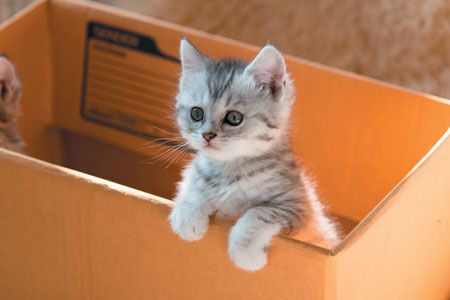
shutterstock.comSocial comfort
The human-animal bond promotes health in both species. Patients often seek contact with familiar people during times of stress. So allowing clients to remain with their pets when feasible can enrich the veterinary experience. Items from home, associated with familiarity, can also provide comfort. Scheduling patients with care providers they prefer provides consistency in social interaction.
Choice
It's not feasible to allow patients complete choice of care, but options provide the perception of choice.
Examine and treat pets in the position and location they're most comfortable. Offer multiple food options in small amounts, use minimal physical restraint and arrange the hospital cage to provide hiding or visual enrichment variety.
Don't forget to offer inexpensive disposable toys to encourage play.
Upcycle materials around your practice for DIY enrichment. Pets can shred cardboard boxes to access food treats.
Folded paper or toilet paper tubes and balls rolled from paper are safe options, as is food smeared on a paper plate for pets awaiting an exam.
Kibble in a pill bottle makes a nice rattling toy.
Hang syringe cases from cage doors for cats to bat.
Sherrie Yuschak, RVT, VTS (behavior), CPDT-KA, is member-at-large of the Academy of Veterinary Behavior Technicians. She is also the owner of Better Behavior Solutions and a clinical behavioral technician at North Carolina State University's College of Veterinary Medicine.